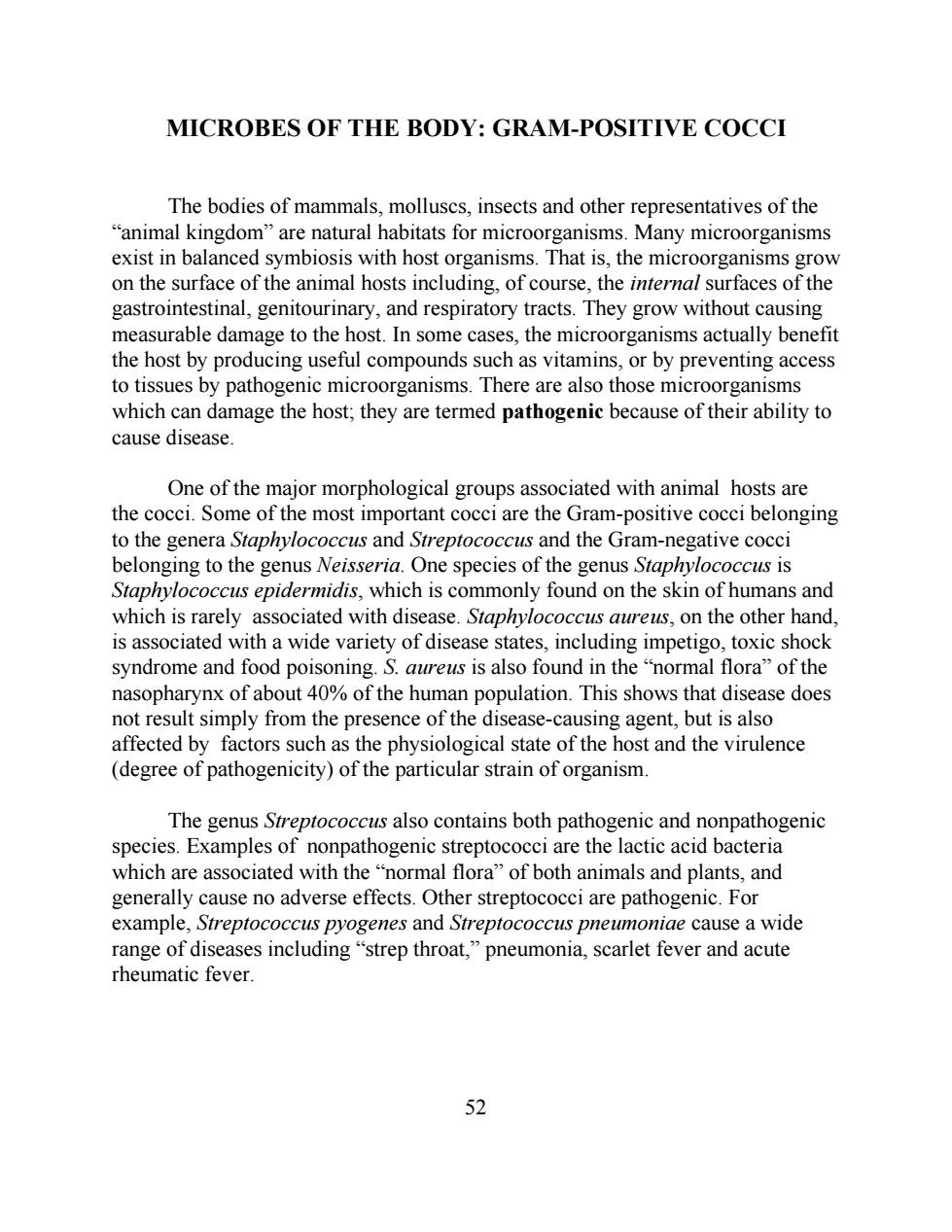正在加载图片...

MICROBES OF THE BODY:GRAM-POSITIVE COCCI The bodies of mammals,molluscs,insects and other representatives of the "animal kingdom"are natural habitats for microorganisms.Many microorganisms exist in balanced symbiosis with host organisms.That is,the microorganisms grow on the surface of the animal hosts including,of course,the internal surfaces of the gastrointestinal,genitourinary,and respiratory tracts.They grow without causing measurable damage to the host.In some cases,the microorganisms actually benefit the host by producing useful compounds such as vitamins,or by preventing access to tissues by pathogenic microorganisms.There are also those microorganisms which can damage the host;they are termed pathogenic because of their ability to cause disease One of the major morphological groups associated with animal hosts are the cocci.Some of the most important cocci are the Gram-positive cocci belonging to the genera Staphylococcus and Streptococcus and the Gram-negative cocci belonging to the genus Neisseria.One species of the genus Staphylococcus is Staphylococcus epidermidis,which is commonly found on the skin of humans and which is rarely associated with disease.Staphylococcus aureus,on the other hand, is associated with a wide variety of disease states,including impetigo,toxic shock syndrome and food poisoning.S.aureus is also found in the"normal flora"of the nasopharynx of about 40%of the human population.This shows that disease does not result simply from the presence of the disease-causing agent,but is also affected by factors such as the physiological state of the host and the virulence (degree of pathogenicity)of the particular strain of organism The genus Streptococcus also contains both pathogenic and nonpathogenic species.Examples of nonpathogenic streptococci are the lactic acid bacteria which are associated with the"normal flora"of both animals and plants,and generally cause no adverse effects.Other streptococci are pathogenic.For example,Streptococcus pyogenes and Streptococcus pneumoniae cause a wide range of diseases including"strep throat,"pneumonia,scarlet fever and acute rheumatic fever. 52 52 MICROBES OF THE BODY: GRAM-POSITIVE COCCI The bodies of mammals, molluscs, insects and other representatives of the “animal kingdom” are natural habitats for microorganisms. Many microorganisms exist in balanced symbiosis with host organisms. That is, the microorganisms grow on the surface of the animal hosts including, of course, the internal surfaces of the gastrointestinal, genitourinary, and respiratory tracts. They grow without causing measurable damage to the host. In some cases, the microorganisms actually benefit the host by producing useful compounds such as vitamins, or by preventing access to tissues by pathogenic microorganisms. There are also those microorganisms which can damage the host; they are termed pathogenic because of their ability to cause disease. One of the major morphological groups associated with animal hosts are the cocci. Some of the most important cocci are the Gram-positive cocci belonging to the genera Staphylococcus and Streptococcus and the Gram-negative cocci belonging to the genus Neisseria. One species of the genus Staphylococcus is Staphylococcus epidermidis, which is commonly found on the skin of humans and which is rarely associated with disease. Staphylococcus aureus, on the other hand, is associated with a wide variety of disease states, including impetigo, toxic shock syndrome and food poisoning. S. aureus is also found in the “normal flora” of the nasopharynx of about 40% of the human population. This shows that disease does not result simply from the presence of the disease-causing agent, but is also affected by factors such as the physiological state of the host and the virulence (degree of pathogenicity) of the particular strain of organism. The genus Streptococcus also contains both pathogenic and nonpathogenic species. Examples of nonpathogenic streptococci are the lactic acid bacteria which are associated with the “normal flora” of both animals and plants, and generally cause no adverse effects. Other streptococci are pathogenic. For example, Streptococcus pyogenes and Streptococcus pneumoniae cause a wide range of diseases including “strep throat,” pneumonia, scarlet fever and acute rheumatic fever